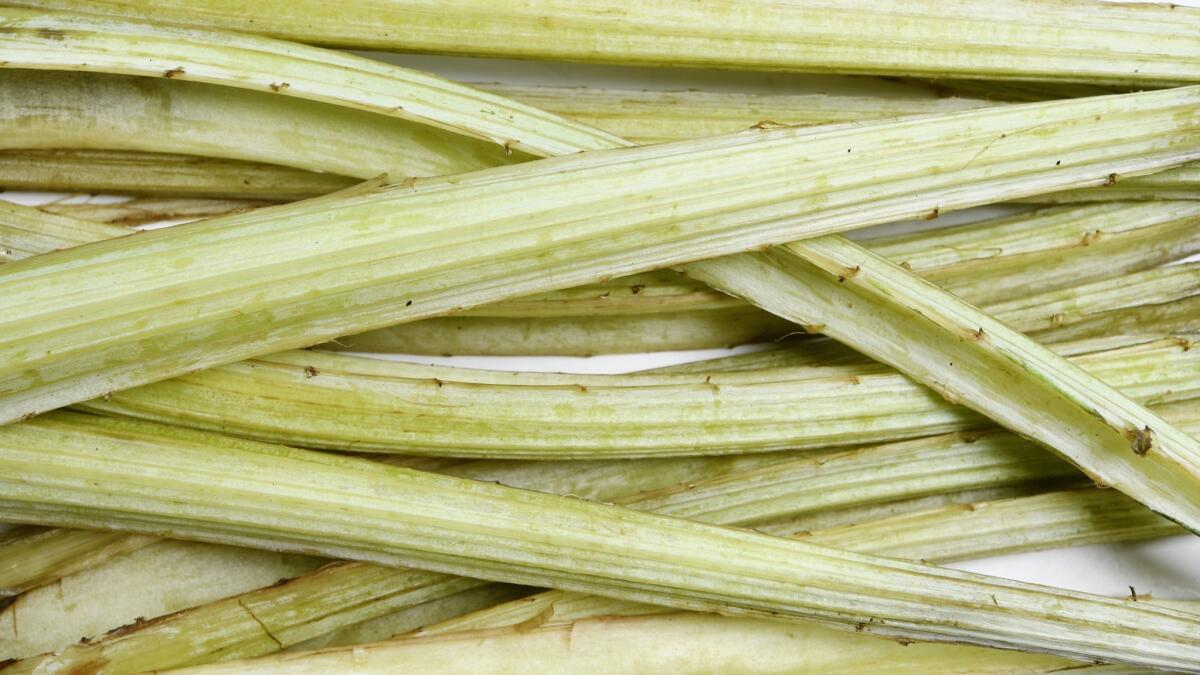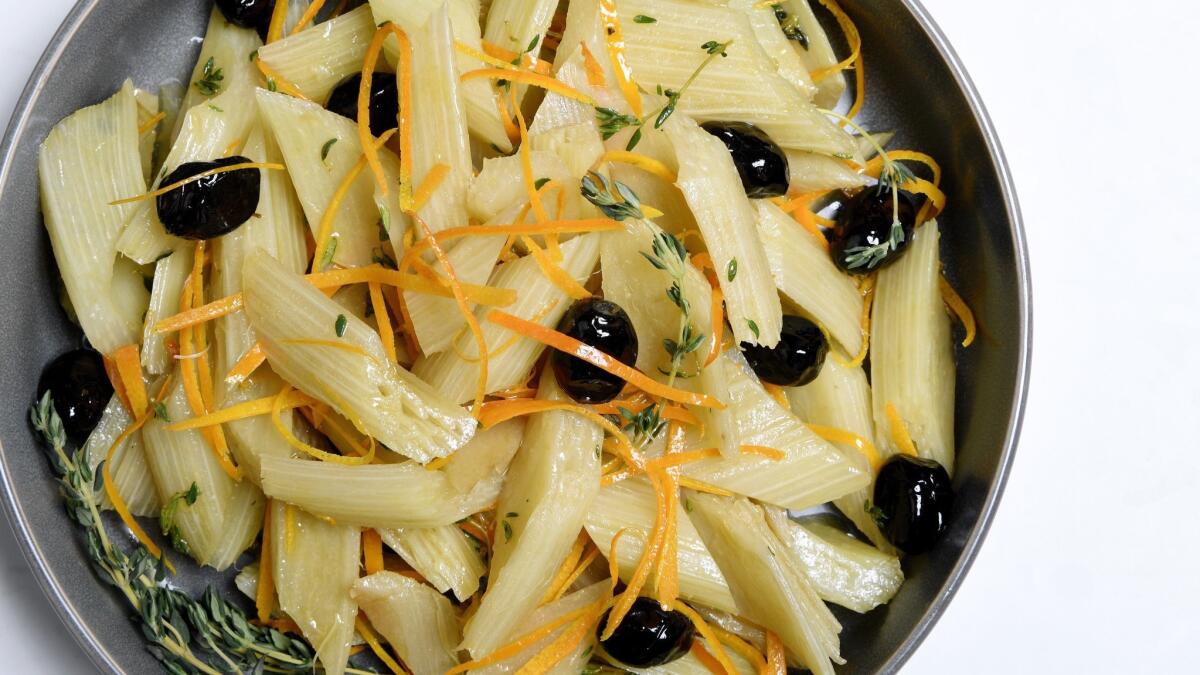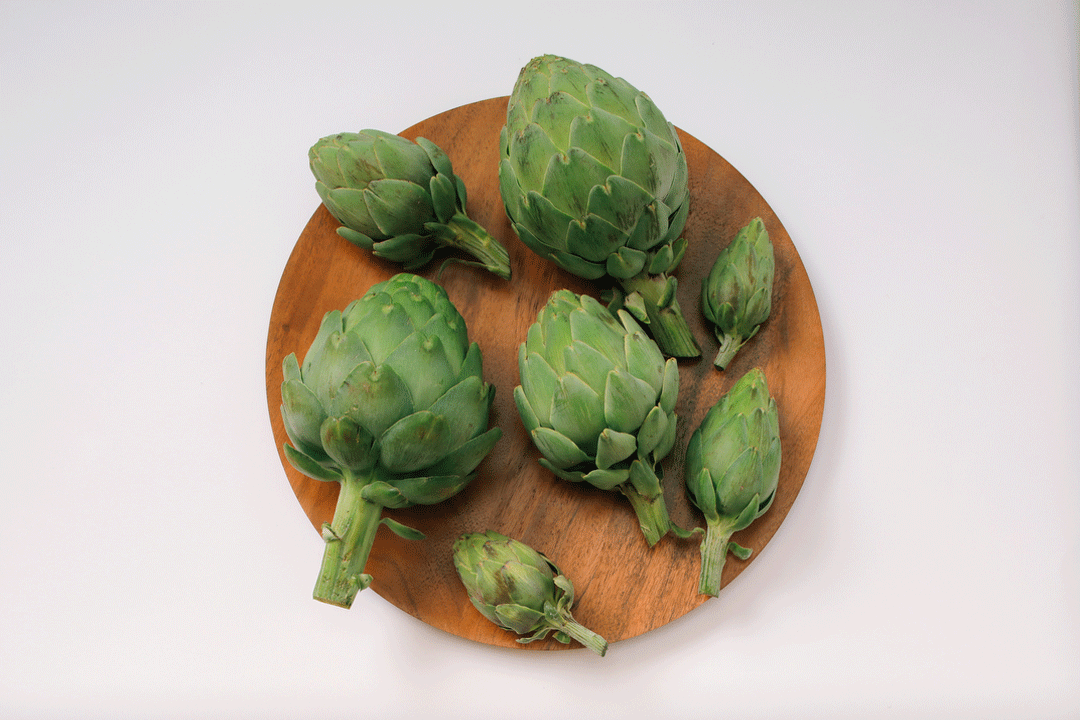Cardoons, the best spring vegetable you’ve never heard of

- Share via
When the vaguely warmer and wetter days of spring arrive, people start jonesing for the best spring produce: artichokes. But when I see an artichoke, I get triggered, remembering hours upon hours of culinary-school service prep when I had to trim their spiny leaves, pare the stems, and scrape out the hairy choke before plunging them into lemon water to keep them from browning — all in under a minute. I began to loathe the sight of them.
Fortunately, the spring produce I get most excited about is the cardoon, relative of the artichoke and a rare delicacy — at least in the U.S.
It’ll start popping up now at specialty food stores and farmers markets — inquire at a stand selling artichokes if you don’t spot it.

The leaf stalk of the globe artichoke plant is what is commonly referred to as a cardoon here in the U.S. Notoriously bitter and riddled with spines, modern cultivars, especially those grown in the U.S. for consumption, have had the painful microscopic spines bred out. Even so, I like to use a kitchen towel when handling them and wear latex gloves to avoid staining my fingers bitter and brown. Although they may seem as annoying to prep as artichokes, I find the process of de-spining and de-stringing the long, wide stalks easier, and more meditative, than dealing with the angular artichoke. Cardoons require a long cooking time to get them anywhere near tender, but thankfully, it’s all hands-off. Their flavor — like an artichoke had a weekend tryst with a celery stalk — warrants an unadulterated preparation that highlights their distinct aroma and texture. They’re a big deal in southern Italy, where they’re dredged in flour and breadcrumbs, fried quickly, and served with lots of fresh lemon.
Welcome to our new food section »
I forgo the usual post-boil deep-fry but keep their flavors local, marinating the cooked cardoons in a simple Sicilian-inspired vinaigrette of orange juice and olive oil. Thin slivers of orange zest and salt-cured olives stud the cardoons and balance their slight bitterness with breaks of sweet acidity and umami richness. Left to soak in the fridge overnight or a few days, the dressing mellows the complex flavor of this mysterious vegetable, the most exciting thing to come out of the dirt this time of year.

Cardoons With Sicilian Olive Vinaigrette
Time: 1 1/2 hours, plus overnight marinating. Makes about 5 cups.
- 1 doorknob-size lemon
- 6 cardoon stalks
- Kosher salt
- 1 navel orange or sweet citrus of equal size
- 1/4 cup olive oil
- 1/2 cup salt-cured black olives
- 6 thyme sprigs, stems removed
- Freshly cracked black pepper
1. Fill a large bowl halfway with cold water. Halve the lemon, squeeze its juice into the water, then add the spent rinds to the water.
2. With a folded kitchen towel in one hand to protect your fingers, use a paring knife to trim off any tiny spines and leaves from the undersides of one cardoon stalk. Use the knife to pare off the strings from the top side of the stalk, like you would for celery. Flip the stalk over and, with the tip of your knife, scrape off any tiny rough skin from the bottom, too. Finally, cut the stalk on a diagonal into rough 1 1/2- to 2-inch-long pieces, discarding the dark ends, and immediately place them in the lemon water to keep them from browning. (Click here for a video.) Repeat with the remaining cardoon stalks; you should have 4 to 5 cups, depending on size.
3. Bring a large pot of salted water to a boil. Drain the cardoon pieces and transfer them to the boiling water. Boil the cardoon pieces for 5 minutes, then drain them again and refill the pot with water to cover the cardoons. Bring the water back to a boil and cook the cardoon pieces until the tip of a paring knife pierces each piece with very little resistance and the pieces are tender when you bite into them, about 1 hour more. Add more water as needed to keep covered.
4. While the cardoons boil, make the vinaigrette: Using a vegetable peeler, pare off the orange’s zest in wide strips, avoiding as much of the white pith as possible. Working in batches, stack the zest strips on top of one another, and use your knife to slice them lengthwise into super-thin matchsticks (or as thin as you can get them). Juice the orange into a bowl (you should get about 1/3 to 1/2 cup juice) and whisk in the olive oil, followed by the orange zest strips, olives and thyme.
5. When the cardoons are tender, drain them, then transfer them to the bowl with the vinaigrette and toss to combine. Allow the cardoons to cool to room temperature, tossing occasionally in the vinaigrette to make sure they’re soaking it all up evenly, and season with salt. Transfer the bowl to the refrigerator and let the cardoons chill, at least overnight or up to three days. Season with black pepper before serving.
More to Read
Eat your way across L.A.
Get our weekly Tasting Notes newsletter for reviews, news and more.
You may occasionally receive promotional content from the Los Angeles Times.











